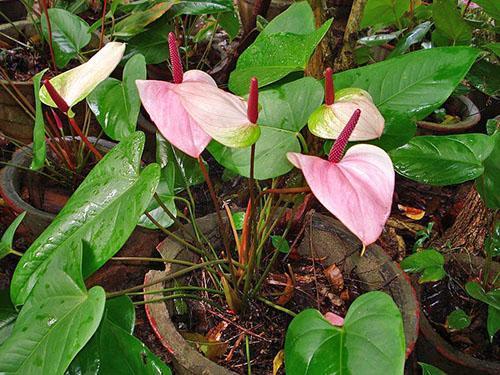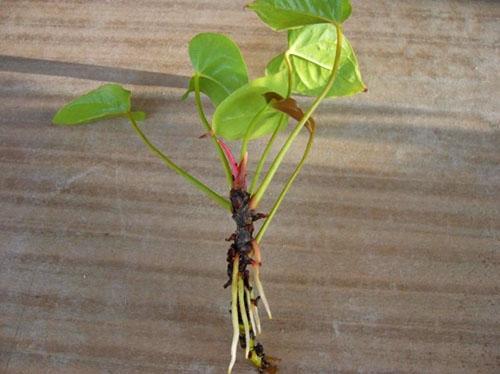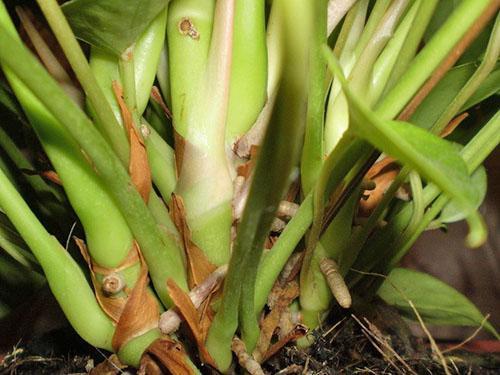Breeding methods for a home anthurium flower
 Anthuriums are one of the most numerous genera in the Aroid family. Today it includes about eight hundred natural species, and breeders have obtained a lot of interesting varieties and hybrids for flower growers. As an indoor flower, anthurium became popular at the end of the last century. Since then, the plant's circle of admirers has only expanded.
Anthuriums are one of the most numerous genera in the Aroid family. Today it includes about eight hundred natural species, and breeders have obtained a lot of interesting varieties and hybrids for flower growers. As an indoor flower, anthurium became popular at the end of the last century. Since then, the plant's circle of admirers has only expanded.
The success of anthurium among floriculture lovers became possible not only due to the relative simplicity of content, spectacular flowering and decorative foliage, but also the ability to propagate a plant you like at home, root a stalk or rejuvenate an existing flower.
Most often, flower growers use vegetative propagation methods, and they take as planting material:
- cuttings with aerial roots;
- the whole top of the plant;
- stem offspring.
Anthurium can also be propagated by seeds, but this is more laborious and time-consuming work.
Advantages and features of vegetative reproduction of anthurium

Anthuriums, in nature, for the most part, are epiphytes, quickly give powerful aerial roots, which they use when rooting stem cuttings, lateral suckers and layering.
In addition, in the two or three years that pass between transplants, the bush grows seriously, and if you plant anthurium flower, you can get from 2 to 5 independent plants. Such a measure should not be neglected, since it only benefits the anthurium and has a beneficial effect on its growth and the quality of flowering.
How to plant anthurium?
 The division of an adult plant allows to rejuvenate the anthurium of many spectacularly flowering and decorative leafy species, as well as to maintain its external attractiveness. The best time for this event is a transplant periodically held in the spring, from the second half of February to May.
The division of an adult plant allows to rejuvenate the anthurium of many spectacularly flowering and decorative leafy species, as well as to maintain its external attractiveness. The best time for this event is a transplant periodically held in the spring, from the second half of February to May.
To separate the plant, you need to prepare in advance:
- a sharp knife treated with alcohol or a strong solution of potassium permanganate;
- a loose soil mixture suitable for the growth of anthurium and disinfected in advance;
- material for arranging the drainage layer, for example, small expanded clay;
- containers with drainage holes for young seedlings.
 Before planting anthurium, the plant must be removed from the pot, trying not to damage the roots. To do this, the earthen lump is watered abundantly so that the moisture saturates the entire soil. Then, having crumpled the pot, the anthurium flower is removed and the substrate trapped inside the root bunch is cleaned from the roots.
Before planting anthurium, the plant must be removed from the pot, trying not to damage the roots. To do this, the earthen lump is watered abundantly so that the moisture saturates the entire soil. Then, having crumpled the pot, the anthurium flower is removed and the substrate trapped inside the root bunch is cleaned from the roots.
If the anthurium blooms at the time of transplantation and separation, it is better to cut the flower stalks in order to facilitate the adaptation period for the plant and reduce the loss of strength and moisture.
The same is done with tall shoots, which can later also be used for flower propagation. But the aerial roots of anthurium should be protected if possible.They can not only become an additional means of delivery of food, but fully replace the insufficiently developed soil root system in seedlings.
 Anthurium can be planted by gradually separating and cutting off young shoots from the edge of the plant. For rooting and subsequent growth, such an anthurium process needs its own growth point, a pair of leaves and at least a pair of rhizomes.
Anthurium can be planted by gradually separating and cutting off young shoots from the edge of the plant. For rooting and subsequent growth, such an anthurium process needs its own growth point, a pair of leaves and at least a pair of rhizomes.
Places of cuts, in order to avoid the appearance of rot or the development of fungal infections, it is useful to process crushed coal. Often, flower growers use ground cinnamon, which also has mild disinfecting properties.
If the shoot of an anthurium flower does not have its own root system, and there are only rudiments of roots on the stem, it is useful to root the plant in wet sphagnum moss or perlite before planting in the ground. As a rule, roots are formed after 7-15 days.
 Viable seedlings, ready for independent existence, can be moved into prepared soil for anthuriums, while it is worth remembering that the growing point cannot be buried, it always remains above the level of moist, loose soil.
Viable seedlings, ready for independent existence, can be moved into prepared soil for anthuriums, while it is worth remembering that the growing point cannot be buried, it always remains above the level of moist, loose soil.
 Young anthuriums can be watered as moisture evaporates from the upper layer of the substrate. It is important to ensure that moisture does not erode the soil and affect the position of the plant until it is firmly entangled with the earthy ball. Further care for the seedling does not differ from what adult anthuriums receive.
Young anthuriums can be watered as moisture evaporates from the upper layer of the substrate. It is important to ensure that moisture does not erode the soil and affect the position of the plant until it is firmly entangled with the earthy ball. Further care for the seedling does not differ from what adult anthuriums receive.
Anthurium is propagated in a similar way if young lateral or basal shoots appear on an adult plant. If anthurium has aerial roots, cutting off and sprinkling the damaged surfaces with coal, the planting material can be safely planted in the ground.
For plants that are warm and with plenty of light, acclimatization will not last longer than a month, after which new foliage can be expected.
A video on how to propagate an anthurium and plant a green pet will help in practice to master all the techniques, and also tell you how to create all the conditions for rooting and rapid development of the plant.
Depending on the age and condition of the rooted plant, anthurium flowering can be expected either this or next year.
Propagation of anthurium by cuttings
 Many types of anthurium can be propagated by cutting off a shoot with aerial roots and several internodes with a sharp knife. Divided into sections with one or two nodes and a pair of leaves, the stem is rooted in moist perlite. The planting depth should not exceed 5 cm, and the growth point of the future plant must be left above the soil. Anthurium cuttings sprinkled with substrate are covered with a film and placed in a warm place, where they have to spend 15–20 days.
Many types of anthurium can be propagated by cutting off a shoot with aerial roots and several internodes with a sharp knife. Divided into sections with one or two nodes and a pair of leaves, the stem is rooted in moist perlite. The planting depth should not exceed 5 cm, and the growth point of the future plant must be left above the soil. Anthurium cuttings sprinkled with substrate are covered with a film and placed in a warm place, where they have to spend 15–20 days.
In a humid atmosphere, roots develop quickly, and the cuttings used to propagate anthurium can soon be transplanted into soil for adult plants.
The main danger with this method of reproduction is rotting of the end parts of the cuttings. Therefore, it is better to sprinkle the sections with coal powder, and sometimes ventilate the contents of the improvised greenhouse.
In order for root shoots to appear as soon as possible, the anthurium needs to create comfortable conditions, including:
- bright, long-lasting, but diffused lighting;
- constant soil and air temperature of about 23–26 ° C;
- maintaining the humidity of the air and soil, for which the plant is irrigated with warm water and aired.
 The appearance of roots in seedlings, about 3-4 cm long, indicates the possibility of their transplantation into the ground.
The appearance of roots in seedlings, about 3-4 cm long, indicates the possibility of their transplantation into the ground.
Young plants should not be rushed to feed, since the root system of a small volume will not be able to absorb fertilizers that have fallen into the soil. They are also capable of causing root burns and the development of foci of infections in the soil.
The part of the old plant remaining in the ground will eventually give new shoots from dormant buds. They can be used to form an existing specimen or, after aerial roots appear on the anthurium, cut off for planting in separate containers.
Reproduction of anthurium by layering
 If the shoots elongate significantly and the plant gradually loses its shape, the top of the stem can be used to propagate the anthurium. To do this, part of the escape:
If the shoots elongate significantly and the plant gradually loses its shape, the top of the stem can be used to propagate the anthurium. To do this, part of the escape:
- frees from dried scales and foliage;
- gently wrap with wet sphagnum;
- and over an impromptu bandage, so that moisture does not evaporate, secure a bag or film.
After a while, the moss begins to penetrate the resulting roots. Such a cutting from the anthurium can be cut and rooted in a separate pot. And the rest of the stem will soon give lateral processes.
Those varieties of anthurium that form long climbing shoots can be rooted by pinning the stem covered with moss directly to the ground.
Mastering all methods of vegetative reproduction of anthurium does not require special knowledge. You just need to remember about maintaining a culture-friendly environment and regular care. Read on the site an article on the reproduction of anthuriums by seeds and leaf plates.
5
They gave me an anthurium stalk without roots, what should I do? To put down roots? The stalk is small.
If this is definitely a stalk, and not just a leaf, then you can help it form its roots. Take a small glass, fill it with either wet sphagnum or perlite, and, as it were, plant a stalk there. Just don't bury it too much. Cover the glass with a bag on top. In a humid environment, the moisture-loving anthurium will already give roots in 1-2 weeks. Remember to ventilate and spray.
Can you put a stalk into the water to form roots?
Rooting cuttings in water is a method that is often used in the propagation of many plants. But in relation to anthurium, it is still better to give preference to rooting in the substrate. Delicate anthurium is very sensitive to excess moisture and reacts painfully to it. If you put the cutting in water, it can rot and disappear. It is better to root not even in the ground, but in perlite - it will maintain the necessary moisture, but at the same time it will protect it from decay.